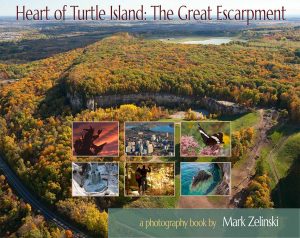Throughout the day, as we searched for and photographed ancient cedars, we crossed paths with numerous hikers at Mount Nemo. They were enjoying a stroll through the forest on a beautiful autumn day. Occasionally they would stop at the many lookout points along the top of the cliff and take in the vista-of-humanity in the valley below—farms, golf courses, and cities—unaware of the ancient world below their feet. An ancient world that Mark hopes to capture and showcase for everybody to see. His work aims to preserve this ancient world in images and words.
I’ve been philosophically wrestling with human impact these days. The conservation versus enjoyment trade-off hangs heavy in my mind. What is that balance between preservation and being able to experience what we are preserving? Is it even meant for us to experience, to enjoy? Does the old environmentalist adage of “leave no trace, take only photographs” still fit with the current, and growing, usage of our parks and natural spaces? We can’t pretend that we have no impact when using these trails. While these trails are created to preserve the environment, they are still highways for humanity into previously natural areas; every footstep a micro-construction site of steamroller compaction and bulldozer erosion. In a world where everyone has a device capable of professional-quality photographs, does a picture of an ancient cedar inspire us to preserve the space, or does it inspire us to go take a selfie with the tree?
Climbers have long been the scapegoat of Escarpment conservation. As we are the only user group on the side of the cliff, we are an easy target. That cliffside ecosystem is ancient–one of the few undisturbed ancient worlds left on Earth. Climbers need to recognize that it isn’t a playground or a climbing gym. We need to educate ourselves on what is being protected, and to try to co-exist with it. It seems the more time we spend in the cliffside environment, the more we are desensitized to its uniqueness and beauty. Mark’s excitement over seeing the amazingly sculpted ancient trees reminded me how lucky we are as climbers to experience this cliffside environment. But it isn’t just the ancient trees, it’s the whole ecosystem that the cliffside supports, itself supported by the trees.
Next time you’re out climbing, open your eyes to the world around you and ask questions. “What’s this plant?” “What’s that tree?” “What type of bird is singing that song?” In doing so, we can deepen our relationship with the natural world. And a deeper relationship will help us remember how special our time is when spent in this space.
Mark’s book, Heart Of Turtle Island: The Great Escarpment, is expected to be released in October 2017. It should be required reading for Escarpment climbers, as the words and images contained within will guide us to deepen our appreciation for our local crags.
http://www.markzelinski.com/books.html
Written by Justin Dwyer
